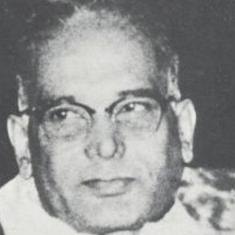Dumka sexual assault: RJD leader blames item songs, ads and pornographic content for rape culture
Shivanand Tiwari claimed that such crimes were ‘unheard of’ in tribal areas earlier.

Rashtriya Janata Dal leader Shivanand Tiwari on Thursday said the objectification of women in “item dance”, certain types of advertisements and pornographic content available on mobile phones was responsible for the rape culture in India, ANI reported.
Tiwari blamed the “consumerist culture” wherein women are presented “like an object to be consumed” for the growing incidence of rape cases, particularly in tribal areas, where crimes like these, he said, “were unheard of” till now.
The RJD leader’s comment came after 17 men allegedly raped a woman in Jharkhand’s Dumka district. The incident took place on the night of December 8, when the woman and her husband were returning from a village market.
She told the police that five men dragged her to the bushes and the other accused overpowered her husband. They took turns to rape her, she said. The police have filed a first information report against the accused.
“No one could’ve imagined there would be rape in a tribal area,” Tiwari told ANI on Thursday. “Rape cases in tribal areas is unheard of. But the objectification of women, rampant in item dance, ads, pornographic content on phones prepare the mindset of rape.”
#WATCH : No one could've imagined there would be rape in tribal area. Item dance, ads, pornographic content on phones prepare mindset of rape. Just making stringent laws won't end it. As long as situation that incites for rape persists, you won't be able to stop it: S Tiwari, RJD pic.twitter.com/xVg6jvDp3G
— ANI (@ANI) December 10, 2020
The politician added that making stringent laws won’t end the problem. “As long as the situation that incites rape persists, you won’t be able to stop it,” Tiwari said.
He noted how the Delhi gangrape of December 2012 led to the state promising a host of reforms, including changing criminal laws and creating a “Nirbhaya Fund” for women’s safety. But despite that, rape cases have evidently risen in the country over the past few years, Tiwari said.
“Rape never existed in tribal culture,” he added. “But it has started since the time people tried modernising these societies. In this consumerist culture, women are presented like consumer’s object.”
India reported 4,05,861 cases of crimes against women in 2019, according to the annual National Crime Record Bureau’s “Crime in India” report released in September. Uttar Pradesh topped the list with 59,853 such incidents.
A grim reminder of this was served on September 29, with the death of a 19-year-old woman from Uttar Pradesh’s Hathras district after being gangraped and subjected to brutal physical assault on September 14 by upper-caste Thakur men.
In the events that followed, the Uttar Pradesh government forcibly cremated the body of the woman even as her family was detained in their home by the police, with the aim to stop the incident from becoming a focus of protests.
The case had promoted nationwide outrage, protests and grief. It had also become emblematic of the caste-based sexual violence faced by Dalit women in the state. As per the National Crime Records Bureau 2019, nearly ten Dalit women are raped every day in the country with Uttar Pradesh recording among the highest numbers.
The Hathras incident also renewed debate about how the police, doctors and even the the government continue to be insensitive towards rape complainants and their families.









